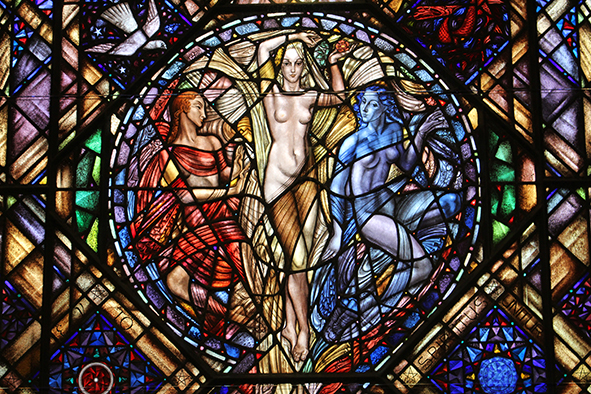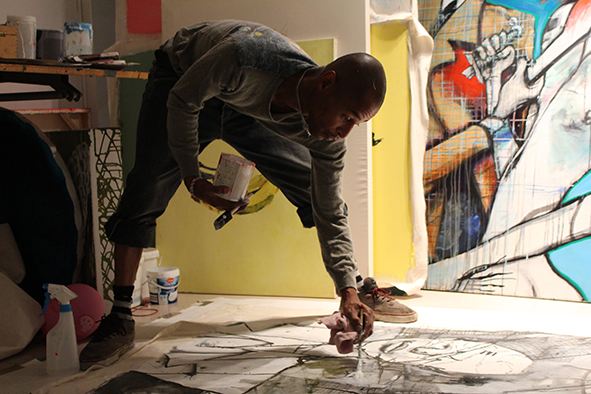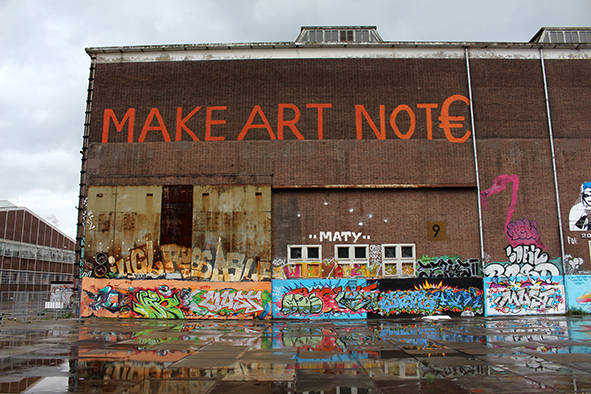Out of Amsterdam’s often overlooked Noord region blooms a vibrant art scene that has begun to reclaim and transform the decaying hulks of defunct heavy industry.
There is a scuttled submarine in shallow water by Amsterdam’s NDSM Quay. In any other European city it may have been dragged to a prominent tourist honey pot and renovated into a major attraction. The only additions to this one were some tasteless graffiti and a weathered orange couch upon its hull to accommodate anybody with a small boat and a penchant for urban exploration.
As an introduction to Amsterdam’s Noord district it is entirely apt. The area is largely derided and overlooked by the majority of ‘Dammers as a post-industrial wasteland, ravaged by the decline of heavy industries like ship building. Many even consider it to be outside the city despite it being just 200m across the Ij from Centraal Station.
Like flowers taking root in cracked asphalt, artists began to relocating to Noord buoyed by the same reasons that breed all artistic communities, like low rents and big open spaces. Today it has transformed into one of the most exciting nascent art districts in Europe, possibly rivaling Berlin now for the best location for creatives on the continent.
Collaborative Reclamation
Noord is a vast region of the city that is dominated by expanses of unused land or monstrous warehouses and factories that lie destitute. Long-since abandoned of their initial purpose, the commercial potential in the region seemed to evaporate, and so art collectives and small start-up businesses have begun to flourish in the industrial wake.
The inherent problem of artistic movements is that they are conspicuous. The attention they attract inevitably makes the regions they populate increasingly popular and attractive to the hip and therefore to investors. That is undeniably the case with Noord. Already a number of cranes have begun to pierce the skyline. But a lot of the investment going into Noord is embracing creativity as much as it is looking to profit from an upcoming area of the city.
Clink has just opened their impressive 750 bed flagship hostel, ClinkNoord. Clink are one of those hostel companies that are really thinking ahead of the game in many ways as to the way hostelling should be done, and ClinkNoord is their statement of intent on that measure. 20% of hostel space is allocated as a common area for guests, and in keeping with the tone of collaboration with the art scene in Noord, they even have a dedicated art space in the hostel to exhibit the work of local artists. This is soon to blossom into a residency program for artists providing support, accommodation and exhibition space for periods of three months at a time.
The interior of ClinkNoord is testament to the respect they have for the local community. Stunning stained glass windows illuminate the stairwells that were a part of the building’s original design from the 1920s. Young, eager local architects were used to design the interior, which itself is a great display of Amsterdam’s local creative talent. There are also plans to begin a program called ‘Stay and play’ similar to the artist residency but for musicians, helping to take them on tour, and offering them a great soundproofed club as part of the hostel, which is an ideal space for gigs. Gallowstreet, an energetic neo-brass ensemble, played the opening night of the hostel. The initiative is a fantastic way for great local music to get an international audience.
Just behind it the EYE Film Museum is Amsterdam’s beautiful ode to cinema. The arts centre juts out over the water like the head of a serpent. Not only is it an architectural marvel, but the contents of the building are engaging and inspirational. Interactive art displays using cameras and special effects slot besides more sophisticated installations exploring the evolution of film.
This is all fantastic development for Noord, which is opening more doors for artists rather than closing them by pushing up rent costs as has happened so frequently in hip areas of London for example.
The Movers and the Painters
Jason started XYZ AMS art collective two years ago, nestled over two floors of a non-descript old warehouse. The walls of his workshop are laden with photography and artworks. On one wall two photos of Snoop Dogg engulfed in a smoky haze hold pride of place. Upstairs five artists are busy at work on their latest creations. Stacks of canvasses, sometimes four deep and in various states of completion, frame a covered workspace where two artists were deeply invested in acrylic interpretations of life as they see it.
“We want to be the face of Amsterdam art to the world, somewhere where we can influence each other and create something unique that does not get attention elsewhere.” Jason says, as he proudly observes Steven agitate a canvas laid horizontally with thick grey emulsion.
“It strikes me as similar to the Cooperative and Anonymous Association of Painters, Sculptors, and Engravers set up by The Impressionists.”
“Exactly! That is where I got the idea from. I was reading about them one day and thought we need to have a place that makes us all focus completely on our work every day.”
Painted Industrial Carcasses
Back over by NDSM the hulks of former shipbuilding factories seem to stand desolate. Bright graffiti reflects double in large puddles swaddling the empty yards in between. But inside one, now called the IJ Hallen, something else manmade is now being born. Whilst being used officially only as a site for a flea market at present, the day I visited leggy models were posing for an elegant photo shoot.
Around the vast sky-lit space, faded cranes towered above the floor like calcified praying mantises. Where they once would have lifted huge metal panels onto half-formed ships they now preside over mighty canvases. Graffiti artists from the world over have been coming to add their creations to what is planned to be the world’s first graffiti gallery. At one end of the factory, two artists were perched atop a raised platform with cans of spray paint, working at a canvas that would dwarf many modest sized houses.
Wandering back to the quay and the submarine, a huge cargo crane had been repurposed into a hotel. It is testament to the power of creative thought and exactly why Noord has started to thrive because that creativity is being given the freedom to express itself through the ruins of the past. The Faralda crane suites might just be Europe’s most unusual place to spend a night in the city; having said that it might have some competition if anybody decides to do something creative with the submarine.






